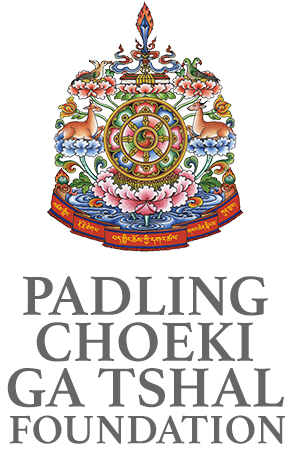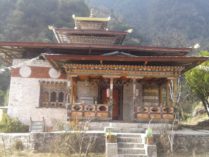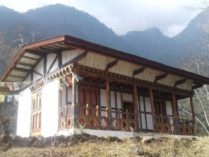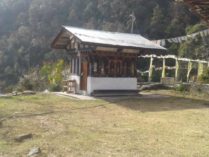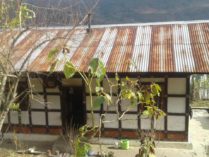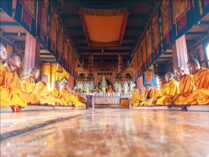Physical Structural Location and Scenery of the Temple
The Temple is situated facing the valley which resembles the crouching elephant towards the east and further facing to the most sacred religious site Fortress of Kurtoe Singye (Kurtoe Singye Dzong) which signifies the successful yogi practices overcoming the external, internal and secret obstacles. Towards the south, in the midst of the magnificent dense forest, the Local Deity and the Protector of the Mountain (Yuelha Siblha) Dorji Karpo and Wangchen Zangmo were dwelling and once they presented themselves in real form in front of the Treasurer Discoverer (Terton) Rigzin Pema Lingpa while he was on his way to Kurtoe and they promised to protect and uphold the spread of the Pema Lingpa’s Doctrine of Concealed Treasures (Pedling Terchoe). Additionally, towards the south of the temple, the sacred sites such as Sangda Kubum, Baeyul Khamphug and Eight Stupas of Buddha (Desheg Choeten Gaeyd) are still to be witnessed which exist without any deterioration of its power of blessings and spiritual accomplishment. In the west of the temple, it can be seen that on the massive and high lofty rocky peak, there is a Precious Religious Vase (Rinchen Bumpa) and the Sacred Hidden Land of Guru Rinpoche known as Khenpajong (Beaeyul Khenpajong). Towards the north, A Stupa of Enlightenment (Jangchub Choeten) built by Pema Lingpa himself for the purpose of spreading Buddhism can be seen along with his own palm print. Moreover, the hot-springs and medicinal waters blessed by Pema Lingpa to cure more than four hundred sicknesses can be also found towards the north of the temple.
The mysterious place was blessed by the visits of Guru Rinpoche, the great saint Melong Dorji and Rigzin Kumaza in eighth century and in the midst of 14th century, second in line to the lineage of Longchen Ramjampa Pal Zangpo, upon knowing about the upcoming serious dispute between Sakya and Phagdrug sect of Buddhism in Tibet, he came towards the south of Tibet in the land of Buddhism, Bhutan and first reached at Kurtoe and established his centre of Buddhist teaching at Kurtoe Kunzangling with the construction of a Buddhist Temple. After its establishment, the Temple served as a centre of his teachings of Great Perfection (Dzogchen) and most profoundly, the temple was a centre of Longchen’s practice of the Evanescent Realization, the pinnacle part of the practice of great perfection (Thoegal Dzongchen).
Kuenkhen and his disciples remained most of the time practicing meditation with very less priority given to the management of the temple and other monasteries built officially. However, towards the later period, Kuenkhen’s disciples and devotees named as Longchen Nyingthik, the lineage holders of Longchen Rabjampa continued to stay at the temple heading the daily religious affairs of the temple. It was in 15th century, that a Buddhist Abbot named Gaydhen Zangpo (Lam Gaydun Zangpo) from Kurtoe who was a true spiritual disciple of Kuenkhen became the head of the Temple. While Lam Gaydun Zangpo was residing at the Valley of Kuri (Kurilung), he was the religious patron for the teachings of Pema Lingpa’s Doctrine of Concealed Treasures (PedlingTerchoe) and with his true devotions and faith for Rigzin Pema Lingpa, he also received many empowerments, oral transmissions and religious instructions of Pedling from Rigzin Pema Lingpa and he became one of the main disciple of Rigzin Pema Lingpa in kurtoe valley. After the death of Longchen Rabjampa, his consort handed over the Kunzangling temple to the lineage holders of Pedling, as she had the great devotions of considering Rigzin Pema Lingpa as a reincarnate of Longchenpa.
Since then, Rigzin Pema Linpa looked after the temple ad started the religious conducts to benefit the spread of Buddhism in the country and also the sentient beings. Specifically, he focused on spreading the Pedling tradition of Buddhism. For the first time, the religious patrons and sponsors of Kunzanling village, the first ever Religious Accomplishment Ceremony of Pedling Abbot Norbu Jamtsho (Lam Norbu Jamtsho) (skye-bdun sha’i-ril-bu) based on Pedling tradition was conducted in Kuenzangling Monastery. Moreover, as requested by a Buddhist Abbot Gayden Zangpo of that locality, (Lam Gyedun Zangpo) and also upon the request made by a Buddhist Abbot named Shang Lama Shakya and his desciples, Rigzin Pema Lingpa gave 25 days religious discourses on Thuje Chenpo Munsel Dronme and Dzogpa Chenpo Kunzang Gongpa Kundue teachings. Just like that, Rigzin Pema Lingpa delivered and disseminated many oral transmissions and teachings of Pedling to the devotees of that area. Later, hereditary son of Pedling, Khedrup Kunga Wangpo, the founder of Kurtoe Khochung Samdrup Choeling Monastery established himself in the temple and was made the centre of meditation which attracted the increasing number of devotees. The second Pedling reincarnation named Gyalwang Tenzin Drakpa who was born nearby Gangteng San-nga Choeling Monastery also lived at the temple for long duration for which it became the central seat of Pedling Tradition of Buddhism and its hereditary lineage holders. It also became the important centre of spreading Pedling tradition towards Kurtoe area. To this day also, the temple is looked after by the ninth reincarnation of Gangteng Trulku named Kunzang Rigzin Pema Namgyal continuing the spread and timely transmission of the teachings of Pema Lingpa’s Doctrine of Concealed Treasures.
The Temple’s External and Internal Sacred Religious Objects
Generally, though the Temple is located at the sacred place blessed by Kuenkhen Longchen Rabjam there are no stories on the installation of any sacred religious objects. The main sacred objects of Kuenzangling Temple includes a statue of Buddha measuring about a height of an arrow, a statue of Guru Rinpoche and a God of Wealth Accumulation (Zamgahala) measuring about one cubit (one foot) made by Rigzin Pema Lingpa himself. Inside the temple, the foot-print of Kuenkhen Longchenpa can be seen on the rock inside his small meditational hermitage. At the back side of the temple, Longchen’s rocky throne can be witnessed where it was used for his meditation of Evanescent Realization (Thoegal). Towards the right side of the temple, there is a Longchen’s Holy water which flows on a same amount for all times and seasons. Just beside that is where the dancing stage of Longchen’s Dakinis (Khandro) in front of his another throne is located. On that rocky stage, Longchen’s teenage foot-print can also be seen very mysteriously which is believed to be said that when Longchenpa was sitting on that rocky throne under his meditative experience, the Dakinis performed the religious offerings through dancing and Longchenpa transformed himself into a teenage boy and while dancing with the Dakinis left his foot-print on that dancing stage rock. Furthermore, on the nearby site of Kunzangling temple where the Precious Religious Vase is located, there is a letter “Hung” inscribed by His Holiness the ninth Gangteng reincarnate Rigzin Pema Namgyal on the rock which beholds a key to that religious vase hidden as treasure.
The offering of entire Kunzangling Temple to His Holiness, the Reincarnate of Gangteng (Gangteng Trulku)
Though for many generations Kunzangling temple was looked after by the descendants of Kurtoe Dhungkar Naktshang and its villagers, in 2008 corresponding to 12th month of Rat Year while Gangteng Trulku Rinpoche was on spiritual visit to Kunzangling via Kurtoe Dungkar, Khenpo Jigme Wangchuk, a true descendants of Dungkhar Nagtshang and his sister offered the entire temple along with the establishment land to Rinpoche on 1st Day of 12th Lunar month coinciding with auspicious traditional day of offering. Referring to auspicious sign and as a symbol of upholding the great deeds of the Pedling Ancestors in spreading Pedling teachings, Rinpoche kindly accepted the offering made and on that particular day itself, His Holiness performed lifelong rituals and bestowed an oral transmissions of Choeyingzoed discovered by Khunkhen Longchen Rabjam to the people of that locality. Since then, monastery is under the care of Rinpoche and His Holiness also appointed Khenpo Jigme Wangchuk himself, a graduate of Gangteng College of Buddhist Studies as Representative Abbot to look after all the affairs related to monastery.
The Complete Renovation and Expansion of Temple; and its Consecration Ceremony
After the centuries of years of its establishment, the temple was merely surviving against the biggest hit of the natural calamities with its materials being so much weakened and it was on the verge of collapsing at any time until Her Majesty late Queen Mother Ashi Phuntsho Choden and Azhi Pema Dechen took the royal patronage of renovating and expanding temple. The renovation and expansion works including the supervisory role was given to former Umze of Lhundrup Rinchentse Dzong. Her Majesty the late Queen Mother also sponsored to bring statue of eleven-faced Budhha awalokitesvara, Guru and Dorjisempa (Vajra Sattva) which were placed as main sacred religious objects of temple. However, after several years of its renovation, it was found that its wooden materials have weakened its strength and also as the temple was deemed very small for the conduct of religious ceremonies and other rituals accommodating very less people, the temple was once again renovated and expanded starting 2011 under the instruction and guidance of His Holiness Gangteng Trulku Rinpoche. The supervision of the work was given to Khenpo Jigme Phuntsho for 5 years. As instructed by His Holiness, the Inner Shrine for Bhutan’s Protecting Deities Mahakala and Palden Lhamo (Goenkhang) was also constructed during the renovation of the temple. A grand consecration ceremony of the temple was conducted in 2016 after the fullest completion of its renovation and expansions works along with a weeklong teaching of Old tradition of Pema Lingpa’s Doctrine of Concealed Treasures given to the people headed by His Eminence the Gangteng Trulku with around hundred monks from Khochung Samdrup Choling Primary School of Buddhist Studies and Mongar Tsakaling Centre of Buddhist Practices.
Annual Religious Rituals and other Activities of the Monastery
Similar to any other religious temples and monasteries in the country, which are the places of offering prayers, devotions and seeking protections, Kurtoe Kunzangling Temple (Lhakhang) also is a place of any religious activities in that locality. However, the temple has other religious activities to be preserved and up-holded which are cultural in nature. Those rituals include the following which are conducted on an annual basis:
- One day Death Anniversary Rituals of Rigzin Pema Lingpa on 3rd day of 1st lunar month of every year.
- The Ritual on the Commemoration of Guru Padmasambhava (Treldha Tshechu) on Birth Anniversary of Guru Rinpoche on 10th day of 5th lunar month of every year.
- One day Feast Offering Ritual (Tshogkhor) on first sermon of Lord Buddha on 4th day of 6th lunar month every year.
- The Ritual of Offerings to all the Protectors of Nyingma School of Buddhism (Kunzangling Choedpa) conducted on every 15th day of 11th lunar month of a year.
- Extended Feast Offering Ritual (Tshogkhor Gaydpa) on Descending Day of Lord Buddha on 22nd of 11th lunar month of every year.
- One day Death Anniversary Rituals of Kunkhen Longchen Rabjam on 18th day of 12th lunar month of every year.
Kunzangling Temple is located around two hours’ drive from the Fortress of Lhuntse (Lhuntse Dzong) and nearby the temple, the sacred site of Precious Religious Vase, Pema Lingpa’s Son Kuenga Wangpo’s centre of residence named Khochung monastery, the centre of Bhutan’s hereditary monarchs known as Nagtshang and other religious sites and sacred places of Guru Rinpoche and Treasure Discoverer (Tenton) Pema Lingpa are seen and witnessed which makes the place religiously very much sacred and pure.
